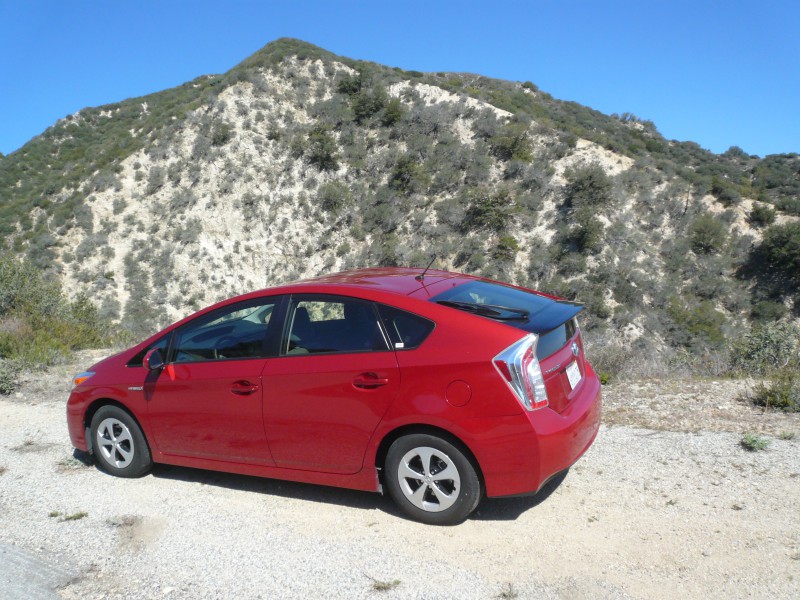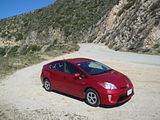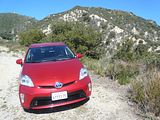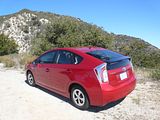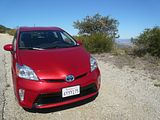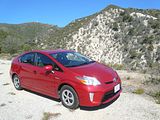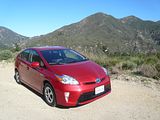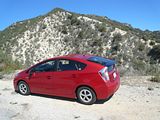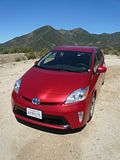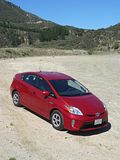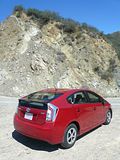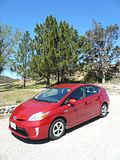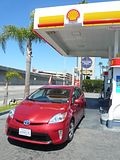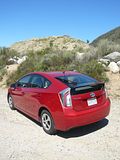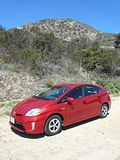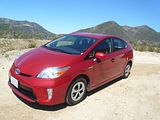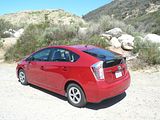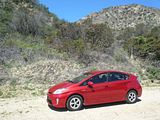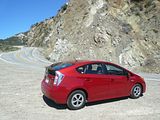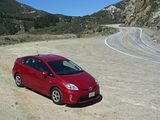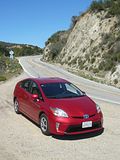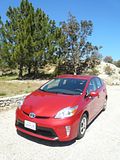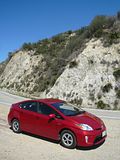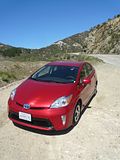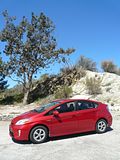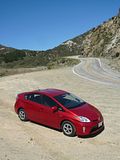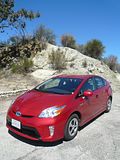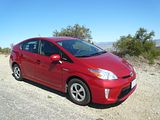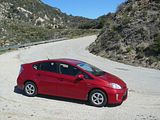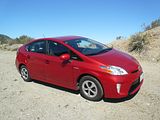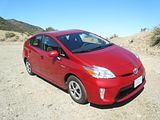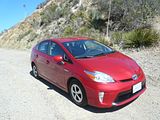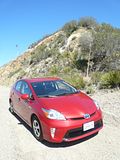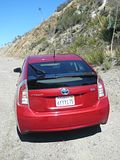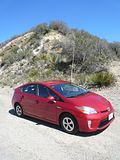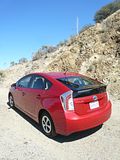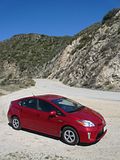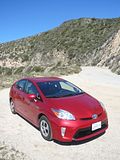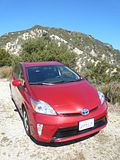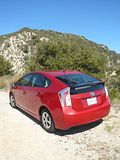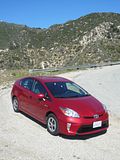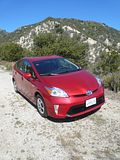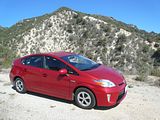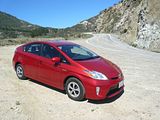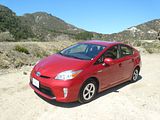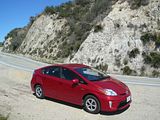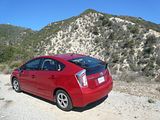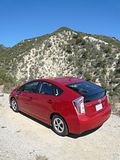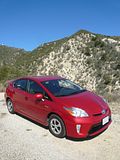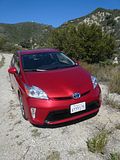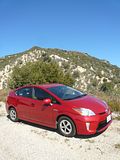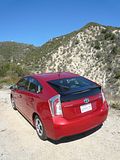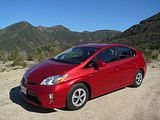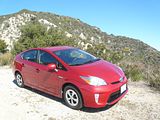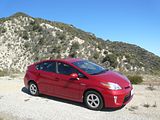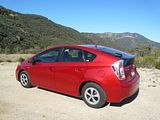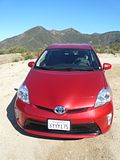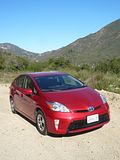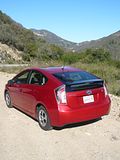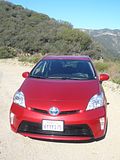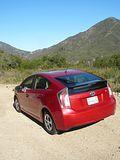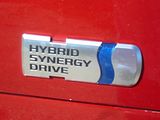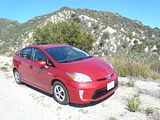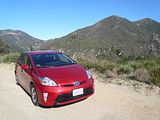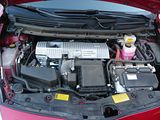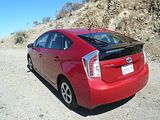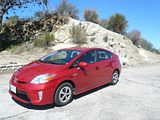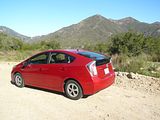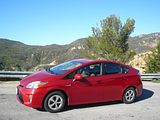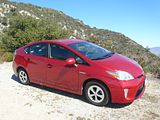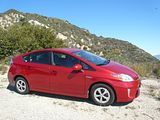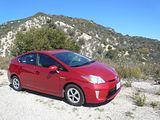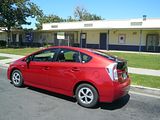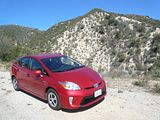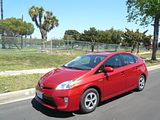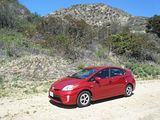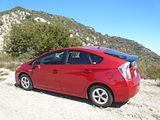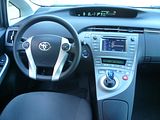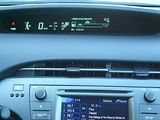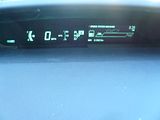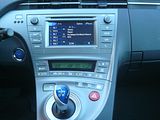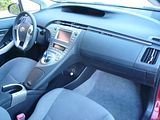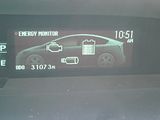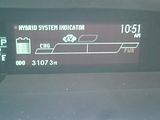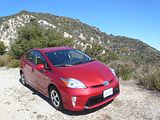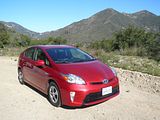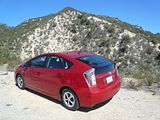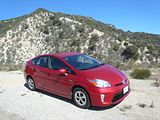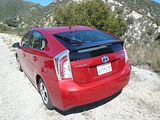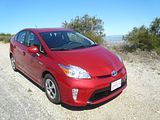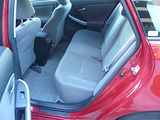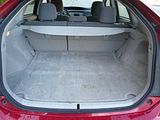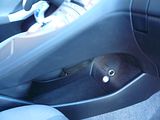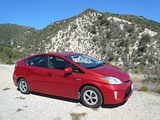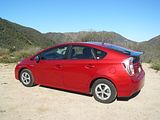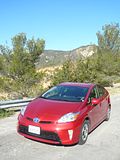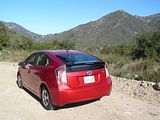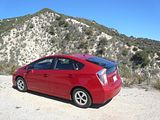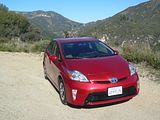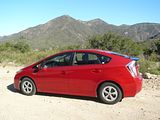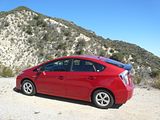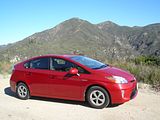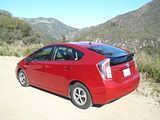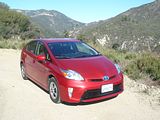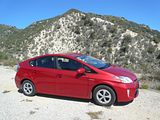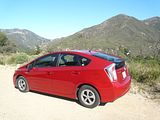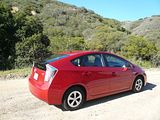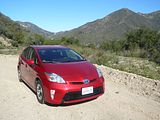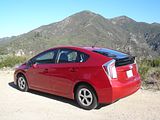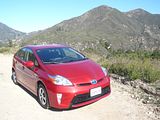After spending a couple of every enjoyable days behind the wheel of a BMW M5, it was inevitable that whatever I selected to drive as the last rental car of this particular US trip was going to be more than an anti-climax, so I figured that the best option was to try to find something that was conceptually as different as possible. When I arrived to collect that final test car, I spotted a freshly washed Toyota Prius had just been parked up in the Gold Choice area, still covered in water droplets from its trip through the car wash. That seemed to be about as far removed from a high performance German sports saloon as you could get, and so I decided to take it. It is customary for car enthusiasts to decry the Prius, but I did feel that there were several reasons why I should sample this big selling car even without the need for automotive contrast. The first of those being the fact that it is an important car in sales terms, with the stats showing that there are months when it is the best selling car in the State of California, and Toyota proudly boasting that they have now sold over 6 million hybrid vehicles in the past 14 years, over 70% of which are Prius models. Secondly, although I had driven a Prius before, that was a second generation car, and since then a third model had been launched and I wanted to see if had addressed the weak points that I found with that Swiss test car. Final reason was that the rental was only going to be for less than a day, so if I really did not take to it, I would not actually have to keep it for very long! And so, I found myself custodian of a 2013 model year Prius in entry level spec which in the US market is called Two, even though there are no badges to tell you this.
The Prius needs little introduction these days, as even most non-enthusiasts have heard of it, and most people have an opinion on it. The third generation model was launched at the 2009 North American International Auto Show in Detroit, and did not depart much from what had proved to be a popular formula in the model it replaced, even down to what has become a trade-mark styling approach, though it featured a number of improvements and a very impressive drag coefficient of cd=0.25. Since then, Toyota updated the Prius for the 2012 model year with a redesigned front bumper with a larger lower grille, as well as new clear lens projector beam headlamps and daytime running lights mounted into the lower bumper and revisions to the rear lights. New Hybrid Synergy blue badging is generously sprinkled on the exterior in order to remind everyone of your environmental do-goodness, whilst inside new upholsteries featured along with an improved multi-informational display with clearer graphics and text, and a 6.1″ touchscreen system which first debuted on the redesigned Toyota Camry was added. Within four years, over 1.67 million third generation Prius models had been sold. Building on that success and strong brand recognition, Toyota has grown the range of Prius models with a larger 7 seater model called Prius+ in Europe and Prius V in America, and they added a smaller model called Prius C (or Acqua in its home market) as well as a Plug-In Hybrid version. There are plenty of badges on the Prius, all with a blue finish, which seems to have become the colour to denote eco-friendliness, to remind everyone of the Hybrid Synergy system that features in the vehicle.
Although there are some characteristics of a Hybrid which by definition do differ from a vehicle that only has an internal combustion engine, such as the fact that you can start up and move away in eery silence just on the batteries, Toyota have tried hard to make sure that the Prius is as easy to drive as possible, and that those differences do not put anyone off. There is no slot for the ignition key, so as long as it is somewhere in proximity, all you do is get in, and press the “Start” button to the right of the wheel. You will hear nothing, of course, but if you watch the dashboard you will see a “Ready” notification at the left hand end of the dashboard which tells you that that the Prius is ready to go. You then either pull the gearlever back a touch to engage Drive or forwards to engage Reverse, and, if someone has set the foot operated parking brake, you need to release that, then off you go. The transmission selector returns to the central position after you have nudged in the way you want to go. If you select Reverse, there is a beeper to alert anyone in the vicinity that the car is about to move. Once you reach a few mph, the petrol engine kicks in, very smoothly, but your ears will tell you it has happened. The Prius then drives pretty much as a “normal” car. There is another thing you do have to remember, though, which is when you want to stop, and park up, there is a button to the upper left of the stubby transmission selector, and you must press this to engage the transmission brake. The last generation Prius that I drove was fine about town, but felt somewhat underpowered once I took to the Autobahns and hilly roads. This generation model has addressed that by fitting a larger 1.8 litre 4 cylinder petrol engine in lieu of the 1.5 that came before. The petrol unit puts out 99 bhp, but when you add in the power of the batteries, you get to 134 bhp and 153 lb/ft of torque. I gave it the tests of both some traffic-free freeway miles and took it up on the relatively steep roads of the Canyons up above Los Angeles, and it acquitted itself far better. It is still not exactly a fast car, but I doubt that anyone buying Prius is expecting that, but nor is it miserably slow, and nor does the engine have to work anything like as hard as it did, which has the twin benefits of reducing the amount of noise and not affecting the fuel consumption so badly. Acceleration from a standing start is modest, but once you are underway, the combination of the petrol engine and batteries means that you can gain momentum both rapidly and smoothly, without what in other cars would need a downchange. Of course the Prius has a CVT gearbox, and this does seem to work well, adjusting the ratio to the consequences of the movement of your right foot very smoothly. I only covered around 100 miles during the day I had the car, so only used a relatively small part of the tank, and when I calculated how much,, it would appear that I achieved 53.3 mpg US, or 67.8 mpg Imperial, which is a very impressive figure indeed.
Keen drivers are not going to be wowed by this car, though the steering is actually more feelsome than in the recently superceded Corolla. It is still pretty numb, but you have at least some sensation of what the road wheels are doing, and you will probably want that when you take to the twisties, which is where you will discover that the Prius understeers, quite a lot, and there is a fair amount of body roll . I am sure you could get yourself into trouble, but this is the sort of car where you probably won’t, and to help out Toyota includes standard fit electronic stability control. Thanks to the long wheelbase and the weight of the batteries towards the back of the car, the Prius rides quite well, dealing with those rough surfaces and potholes at least as well as most other cars I have driven in the LA area recently, reinforcing the view that this is a Cruiser not a car for any Fun. The brakes are smooth and light. Using them does help to regenerate the batteries, as you can see if you have the display set up to show you this. I did not find issues, but I have read lots of complaints that the transition to battery recharging does make them feel mushy. Others have also complained about visibility, but I found that although there is a strip across the rear window section which is blocked out, the fact that there is an area of glass below this helps out massively, as otherwise the steeply raked rear screen would make it quite hard to judge the back end of the car. The front quarter lights help avoid any serious blind spots with the screen pillars for places such as angled junctions.
The interior of this generation of Prius follows closely on the style adopted by its predecessor. There are no instruments or dials directly in front of the driver. Everything is in an elliptical pod high up on the top and centre of the dash. All the dials are electronic, so there is just a blank screen when the ignition is not on. At the left most end is a bar chart fuel gauge, and then you find a digital speedometer, a mpg gauge, a pictogram showing transmission selection and the a display which you can cycle through which will show you all manner of different things from the state of charge of the batteries, to bar charts showing efficiencies achieved over the past few months. Needless to say, there is no rev counter at all. Although it is all a long way away, and noticeably to the right of your natural line of sight, it is all quite easy to read. The central part of the dashboard is far more conventional containing a display unit for what turned out to be quite a simple audio unit, operated by a series of buttons and knobs that surround it, and below this are a further series of flush buttons for the climate control system. Conventional column stalks operate the indicators and lights from the left and wipers on the right. There are wheel mounted buttons for some of the audio unit functions and for cruise control, though the full functions for this latter are on a smaller stalk lower to the right of the wheel. The wheel itself was a plastic moulded item in this test car, but was not unpleasant to hold. The dashboard has a rather odd grained texture which looks like lots of little hairs were left in the moulding, and there are chrome inserts in the air vents and around the door pulls, and grey metal trim inserts on the steering wheel, and around the transmission selector to provide some relief from what otherwise would be an all black appearance. Even so, the plastics are hard, and you don’t exactly feel like you are getting much in the way of a premium experience.
Seat adjustment is all manual, with a bar under the seat for fore/aft movement, and ratchet levers on the side for backrest rake and height. The steering column goes up and down and telescopes in/out. It was not hard to get the driving position I wanted. Others have complained that the seats are thin and under-padded. Maybe because I did not spend long enough at the wheel before hopping out to do photos or for other interruptions, I did not experience any discomfort, but I did only have the Prius for a day and only covered 100 miles in that time. They were trimmed in a cloth material in the test car.
The Prius has become popular as a taxi, and it’s not hard to see that it is not just the low running costs that attract the hackney trade, as this is a very roomy car. I found this out on the previous generation model, and this one continues the tradition. There is far more space in the rear seat than you would expect, with plentiful legroom, a good amount of headroom, and enough width that you could get three adults across the seat, though you do need to be aware that there are vents for the batteries between the edge of the right hand side of the seat backrest and the door pillar. The boot is a good size, too. A load cover was fitted, and my suitcase easily slid underneath it, covering only part of the floor. More space can be created by folding the rear seats forward, with the asymmetrically split backrests dropping onto the rear seat cushions to create a long and flat loadspace. There is a bit of space under the boot floor for odds and ends. Inside the cabin as well as the door bins which only feature in the front and cubby under the central armrest, there is a split level glovebox and a particularly large stowage area under the raised transmission selector area, though this would be quite awkward to access whilst on the move. Rear seat occupants get pockets on the back of the front seats and cupholders in the obverse of the drop down central armrest. There is just one cupholder for the front seat occupants.
US market Prius are sold in five trim variants, which take numeric identifiers, being the Two, Three, Four and Five. There is no badging to tell you which is which, but looking at the standard specs of each, it would seem pretty clear that my test car was the entry level model, a Two. That means you get plastic wheel covers, no XM Satellite radio and a distinct absence of leather anywhere near the cabin. You do get a six-speaker CD audio system with a 6.1″ touch-screen display, a USB port, Bluetooth phone and audio streaming, The Three adds a smart key entry system, Toyota’s Entune entertainment system, for which you need a subscription and an App on your phone and which only works when you have a live connection with the phone, satellite navigation and a reversing camera. The Four adds SofTex-trimmed seats and steering wheel, an 8-way power-adjustable heated driver’s seat with power lumbar support, JBL GreenEdge speakers with amplifier and an auto-dimming rearview mirror with HomeLink . The top spec Five adds 17″ 5-spoke alloy wheels with P215/45R17 tyres, LED headlights with auto level control, auto on/off feature and headlight cleaners and integrated fog lights. Optional features include dynamic radar cruise control, lane keep assist, a moonroof with solar panels that power the ventilation system, remote air conditioning (which can cool the Prius down before you get in) and Toyota’s Safety Connect telematics system, which includes automatic collision notification, a stolen vehicle locator, an emergency SOS button and roadside assistance. The Two starts off at $24,200 and the Five lists for $30,005.
Most people have strong feelings about the Prius, and it is not hard to see why. Ignoring the image that the car projects – and that is certainly part of the reason why many will have strong feelings either for or against – there are 2 ways of looking at this car. You could apply the same sort of criteria that you apply to any other vehicle, and conclude that the performance is mediocre, it’s nothing special to drive with dull steering and handling, and it has a slightly wacky but rather cheap feeling interior. Or you could admire the technology, which clearly does work and is evidently durable for many years, the economy savings that come with it, be grateful for the roominess for people and luggage and conclude that, as a Toyota, the ownership experience will be good. Both are entirely valid viewpoints, and I suspect there is next to no middle ground. Which way you choose to decide will depend on your priorities, but I suspect that for most enthusiasts, the Prius will not be something that they would want to have on their driveway, certainly as their only car. That would certainly apply to me. But having driven the latest car, I can understand why quite so many people have bought one (or indeed more than one), and why they are delighted with their purchase. Renting one for a day or two is a good way to find out what you think.

